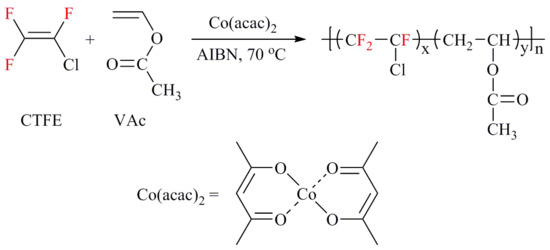Cobalt-Mediated Radical Copolymerization of Chlorotrifluoroethylene and Vinyl Acetate
Abstract
:1. Introduction
2. Experimental
2.1. Materials
2.2. Characterization
2.3. Synthetic Procedures
2.3.1. General Procedure for Co(acac)2-Mediated Copolymerization of CTFE and VAc
2.3.2. General Procedure for Chain Extension Polymerization with VAc
3. Results and Discussion
4. Conclusions
Author Contributions
Funding
Conflicts of Interest
References
- Hougham, G.G.; Cassidy, P.E.; Johns, K.; Davidson, T. Fluoropolymers 1: Synthesis; Springer Science & Business Media: New York, NY, USA, 1999. [Google Scholar]
- Smart, B. Properties of fluorinated compounds, physical and physicochemical properties. Chem. Organ. Fluorine Compd. II 1995, 187, 979. [Google Scholar]
- Yamabe, M. A Challenge to Novel Fluoropolymers; Macromolecular Symposia; Wiley Online Library: Hoboken, NJ, USA, 1992; pp. 11–18. [Google Scholar]
- Ameduri, B.; Boutevin, B. Well-Architectured Fluoropolymers: Synthesis, Properties and Applications: Synthesis, Properties and Applications; Elsevier: Amsterdam, The Netherlands, 2004. [Google Scholar]
- Wang, W.; Yan, D.; Bratton, D.; Howdle, S.M.; Wang, Q.; Lecomte, P. Charge transfer complex inimer: A facile route to dendritic materials. Adv. Mater. 2003, 15, 1348–1352. [Google Scholar] [CrossRef]
- Wang, P.; Dai, J.; Liu, L.; Dong, Q.; Wang, H.; Bai, R. Synthesis and properties of a well-defined copolymer of chlorotrifluoroethylene and n-vinylpyrrolidone by xanthate-mediated radical copolymerization under 60 co γ-ray irradiation. Polym. Chem. 2014, 5, 6358–6364. [Google Scholar] [CrossRef]
- Wang, P.; Dai, J.; Liu, L.; Jin, B.; Bai, R. Xanthate-mediated living/controlled radical copolymerization of hexafluoropropylene and butyl vinyl ether under 60co γ-ray irradiation and preparation of fluorinated polymers end-capped with a fluoroalkyl sulfonic acid group. Polym. Chem. 2013, 4, 1760–1764. [Google Scholar] [CrossRef]
- Boschet, F.; Ameduri, B. (co)polymers of chlorotrifluoroethylene: Synthesis, properties, and applications. Chem. Rev. 2013, 114, 927–980. [Google Scholar] [CrossRef] [PubMed]
- Girard, E.; Marty, J.-D.; Ameduri, B.; Destarac, M. Direct synthesis of vinylidene fluoride-based amphiphilic diblock copolymers by raft/madix polymerization. ACS Macro Lett. 2012, 1, 270–274. [Google Scholar] [CrossRef]
- Alaaeddine, A.; Boschet, F.; Ameduri, B.; Boutevin, B. Synthesis and characterization of original alternated fluorinated copolymers bearing glycidyl carbonate side groups. J. Polym. Sci. Part A Polym. Chem. 2012, 50, 3303–3312. [Google Scholar] [CrossRef]
- Liu, L.; Lu, D.; Wang, H.; Dong, Q.; Wang, P.; Bai, R. Living/controlled free radical copolymerization of chlorotrifluoroethene and butyl vinyl ether under 60co γ-ray irradiation in the presence of s-benzyl o-ethyl dithiocarbonate. Chem. Commun. 2011, 47, 7839–7841. [Google Scholar] [CrossRef]
- Kostov, G.; Boschet, F.; Buller, J.; Badache, L.; Brandsadter, S.; Ameduri, B. First amphiphilic poly (vinylidene fluoride-co-3,3,3-trifluoropropene)-b-oligo (vinyl alcohol) block copolymers as potential nonpersistent fluorosurfactants from radical polymerization controlled by xanthate. Macromolecules 2011, 44, 1841–1855. [Google Scholar] [CrossRef]
- Santhosh, K.K.S.; Ameduri, B. Synthesis and characterization of epoxy functionalized cooligomers based on chlorotrifluoroethylene and allyl glycidyl ether. J. Polym. Sci. Part A Polym. Chem. 2010, 48, 3587–3595. [Google Scholar] [CrossRef]
- Kyulavska, M.; Kostov, G.; Ameduri, B.; Mateva, R. Unexpected alternating radical copolymerization of chlorotrifluoroethylene with 3-isopropenyl-α,α′-dimethylbenzyl isocyanate. J. Polym. Sci. Part A Polym. Chem. 2010, 48, 2681–2697. [Google Scholar] [CrossRef]
- Boschet, F.D.R.; Cracowski, J.-M.; Montembault, V.R.; Ameduri, B. Radical copolymerization of α,β-difluoroacrylic acid with vinylidene fluoride. Macromolecules 2010, 43, 4879–4888. [Google Scholar] [CrossRef]
- Valade, D.; Boschet, F.; Améduri, B. Synthesis and modification of alternating copolymers based on vinyl ethers, chlorotrifluoroethylene, and hexafluoropropylene. Macromolecules 2009, 42, 7689–7700. [Google Scholar] [CrossRef]
- Lu, Y.; Claude, J.; Neese, B.; Zhang, Q.; Wang, Q. A modular approach to ferroelectric polymers with chemically tunable curie temperatures and dielectric constants. J. Am. Chem. Soc. 2006, 128, 8120–8121. [Google Scholar] [CrossRef] [PubMed]
- Shi, Z.; Holdcroft, S. Synthesis and proton conductivity of partially sulfonated poly ([vinylidene difluoride-co-hexafluoropropylene]-b-styrene) block copolymers. Macromolecules 2005, 38, 4193–4201. [Google Scholar] [CrossRef]
- Gaboyard, M.; Hervaud, Y.; Boutevin, B. Photoinitiated alternating copolymerization of vinyl ethers with chlorotrifluoroethylene. Polym. Int. 2002, 51, 577–584. [Google Scholar] [CrossRef]
- Boutevin, B.; Cersosimo, F.; Youssef, B. Studies of the alternating copolymerization of vinyl ethers with chlorotrifluoroethylene. Macromolecules 1992, 25, 2842–2846. [Google Scholar] [CrossRef]
- Jin, C.; Otsuhata, K.; Tabata, Y. Radiation-induced copolymerization of n-vinylpyrrolidone with monochlorotrifluoroethylene. J. Macromol. Sci. -Chem. 1985, 22, 379–386. [Google Scholar] [CrossRef]
- Tabata, Y.; Du Plessis, T. Radiation-induced copolymerization of chlorotrifluoroethylene with ethyl vinyl ether. J. Polym. Sci. Part A Polym. Chem. 1971, 9, 3425–3435. [Google Scholar] [CrossRef]
- Ragazzini, M.; Garbuglio, C.; Carcano, D.; Minasso, B.; Cevidalli, G. Copolymerization of ethylene and chlorotrifluoroethylene by trialkylboron catalysts—I. Polymerization and reactivity ratios. Eur. Polym. J. 1967, 3, 129–136. [Google Scholar] [CrossRef]
- Garbuglio, C.; Ragazzini, M.; Pilati, O.; Carcano, D.; Cevidalli, G. Copolymerization of ethylene and chlorotrifluoroethylene by trialkylboron catalysts—II. Physico-chemical characterization of the copolymers. Eur. Polym. J. 1967, 3, 137–144. [Google Scholar] [CrossRef]
- Guerre, M.; Uchiyama, M.; Lopez, G.; Améduri, B.; Satoh, K.; Kamigaito, M.; Ladmiral, V. Synthesis of peve-b-p(ctfe-alt-eve) block copolymers by sequential cationic and radical raft polymerization. Polym. Chem. 2018, 9, 352–361. [Google Scholar] [CrossRef]
- Tatemoto, M.; Nakagawa, T. German patent 2,729,671. Chem. Abstr. 1978, 88, 137374. [Google Scholar]
- David, G.; Boyer, C.; Tonnar, J.; Ameduri, B.; Lacroix-Desmazes, P.; Boutevin, B. Use of iodocompounds in radical polymerization. Chem. Rev. 2006, 106, 3936–3962. [Google Scholar] [CrossRef] [PubMed]
- Boyer, C.; Ameduri, B.; Hung, M.H. Telechelic diiodopoly(vdf-co-pmve) copolymers by iodine transfer copolymerization of vinylidene fluoride (vdf) with perfluoromethyl vinyl ether (pmve). Macromolecules 2010, 43, 3652–3663. [Google Scholar] [CrossRef]
- Sawada, H.; Tashima, T.; Nishiyama, Y.; Kikuchi, M.; Goto, Y.; Kostov, G.; Ameduri, B. Iodine transfer terpolymerization of vinylidene fluoride, α-trifluoromethacrylic acid and hexafluoropropylene for exceptional thermostable fluoropolymers/silica nanocomposites. Macromolecules 2011, 44, 1114–1124. [Google Scholar] [CrossRef]
- Kamigaito, M.; Ando, T.; Sawamoto, M. Metal-catalyzed living radical polymerization. Chem. Rev. 2001, 101, 3689–3746. [Google Scholar] [CrossRef] [PubMed]
- Moad, G.; Rizzardo, E.; Thang, S.H. Living radical polymerization by the raft process-a second update. Aust. J. Chem. 2009, 62, 1402–1472. [Google Scholar] [CrossRef]
- Hawker, C.J.; Bosman, A.W.; Harth, E. New polymer synthesis by nitroxide mediated living radical polymerizations. Chem. Rev. 2001, 101, 3661–3688. [Google Scholar] [CrossRef] [PubMed]
- Wayland, B.B.; Poszmik, G.; Mukerjee, S.L.; Fryd, M. Living radical polymerization of acrylates by organocobalt porphyrin complexes. J. Am. Chem. Soc. 1994, 116, 7943–7944. [Google Scholar] [CrossRef]
- Arvanitopoulos, L.D.; Greuel, M.P.; Harwood, H.J. Living free-radical polymerization using alkyl cobaloximes as photoinitiators. Abstr. Pap. Am. Chem. Soc. 1994, 208, 402. [Google Scholar]
- Banerjee, S.; Ladmiral, V.; Debuigne, A.; Detrembleur, C.; Poli, R.; Ameduri, B. Organometallic-mediated radical polymerization of vinylidene fluoride. Angew. Chem. 2018, 57, 2934–2937. [Google Scholar] [CrossRef] [PubMed]
- Demarteau, J.; Améduri, B.; Ladmiral, V.; Mees, M.A.; Hoogenboom, R.; Debuigne, A.; Detrembleur, C. Controlled synthesis of fluorinated copolymers via cobalt-mediated radical copolymerization of perfluorohexylethylene and vinyl acetate. Macromolecules 2017, 50, 3750–3760. [Google Scholar] [CrossRef]
- Banerjee, S.; Ladmiral, V.; Debuigne, A.; Detrembleur, C.; Rahaman, S.M.W.; Poli, R.; Ameduri, B. Organometallic-mediated alternating radical copolymerization of tert-butyl-2-trifluoromethacrylate with vinyl acetate and synthesis of block copolymers thereof. Macromol. Rapid Commun. 2017, 38. [Google Scholar] [CrossRef]
- Banerjee, S.; Bellan, E.; Gayet, F.; Debuigne, A.; Detrembleur, C.; Poli, R.; Améduri, B.; Ladmiral, V. Bis(formylphenolato)cobalt(ii)-mediated alternating radical copolymerization of tert-butyl 2-trifluoromethylacrylate with vinyl acetate. Polymers 2017, 9, 702. [Google Scholar] [CrossRef]
- Peng, C.H.; Yang, T.Y.; Zhao, Y.; Fu, X. Reversible deactivation radical polymerization mediated by cobalt complexes: Recent progress and perspectives. Organ. Biomol. Chem. 2014, 12, 8580–8587. [Google Scholar] [CrossRef]
- Debuigne, A.; Poli, R.; Jérôme, C.; Jérôme, R.; Detrembleur, C. Overview of cobalt-mediated radical polymerization: Roots, state of the art and future prospects. Prog. Polym. Sci. 2009, 34, 211–239. [Google Scholar] [CrossRef]
- Debuigne, A.; Champouret, Y.; Jerome, R.; Poli, R.; Detrembleur, C. Mechanistic insights into the cobalt-mediated radical polymerization (cmrp) of vinyl acetate with cobalt(iii) adducts as initiators. Chem. -Eur. J. 2008, 14, 4046–4059. [Google Scholar] [CrossRef]
- Carnevale, D.; Wormald, P.; Ameduri, B.; Tayouo, R.; Ashbrook, S.E. Multinuclear magnetic resonance and dft studies of the poly (chlorotrifluoroethylene-alt-ethyl vinyl ether) copolymers. Macromolecules 2009, 42, 5652–5659. [Google Scholar] [CrossRef]

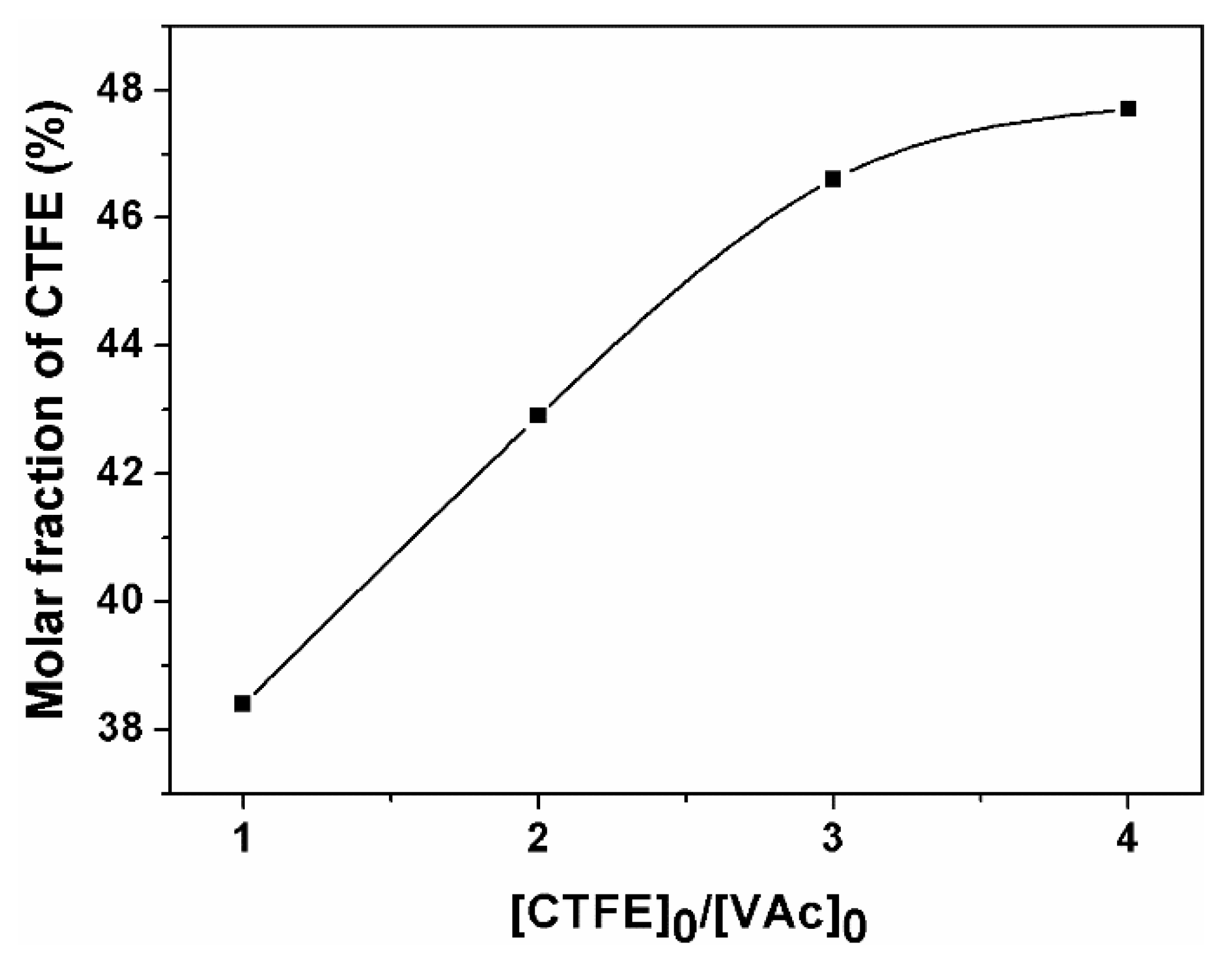
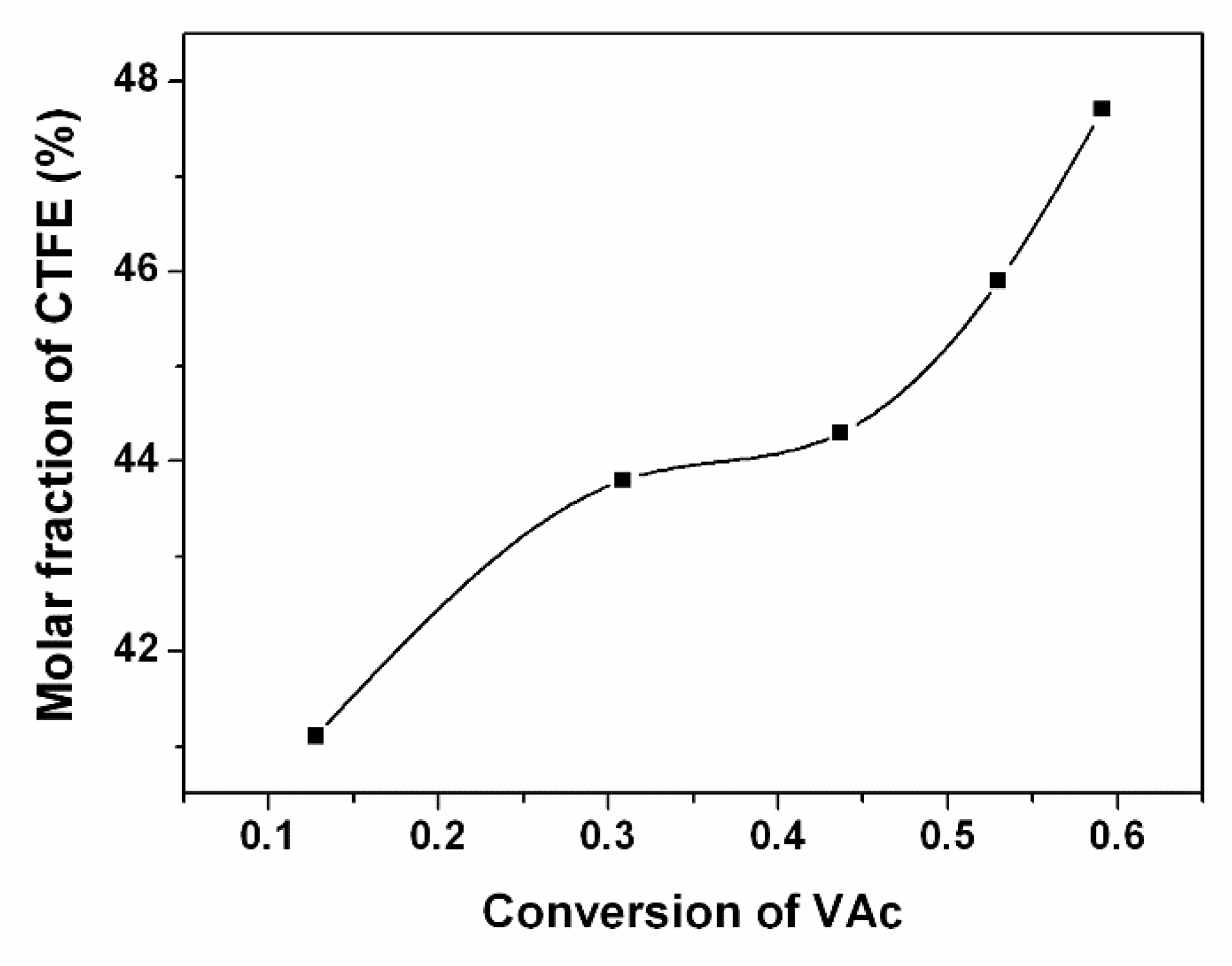
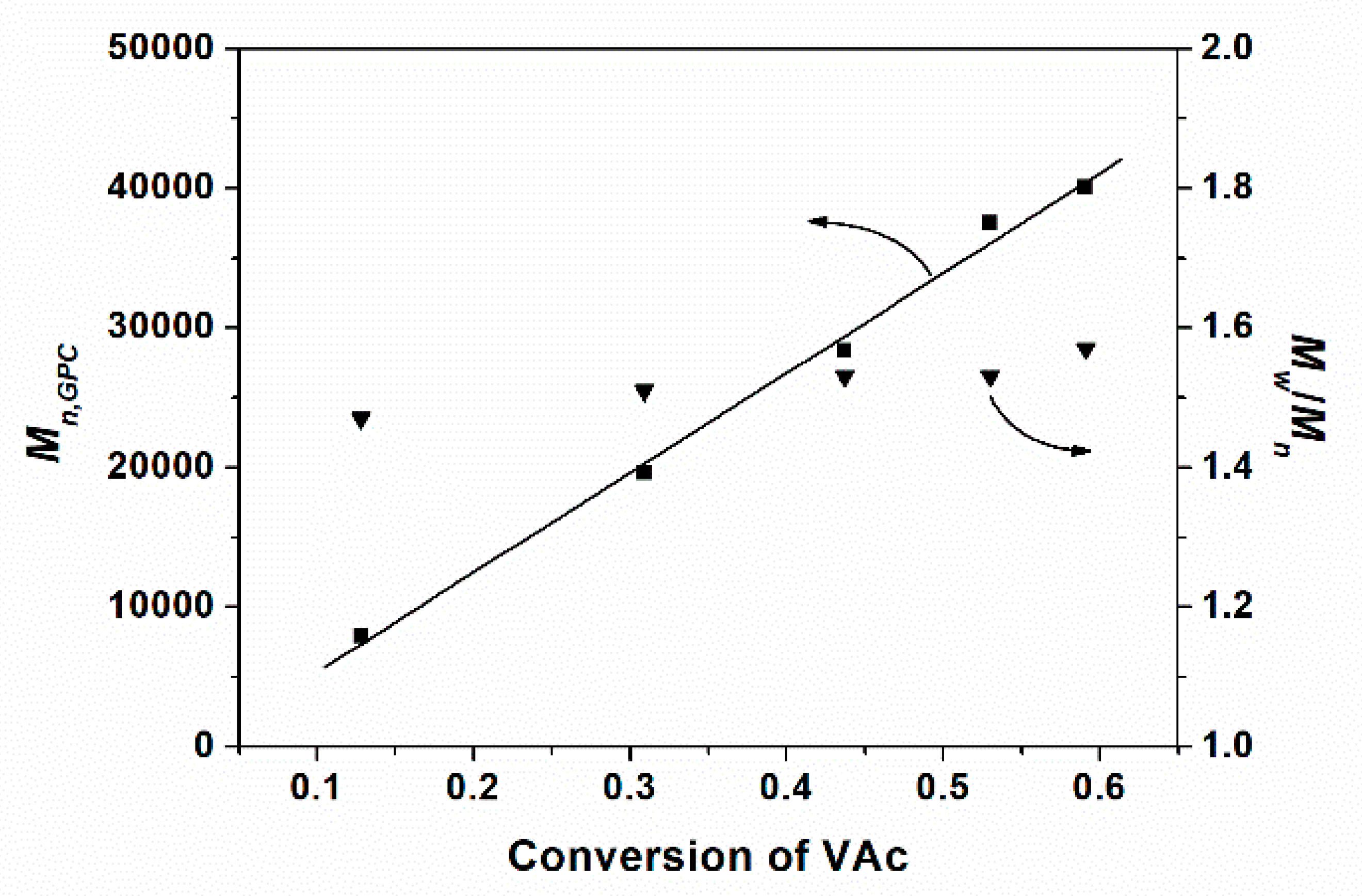
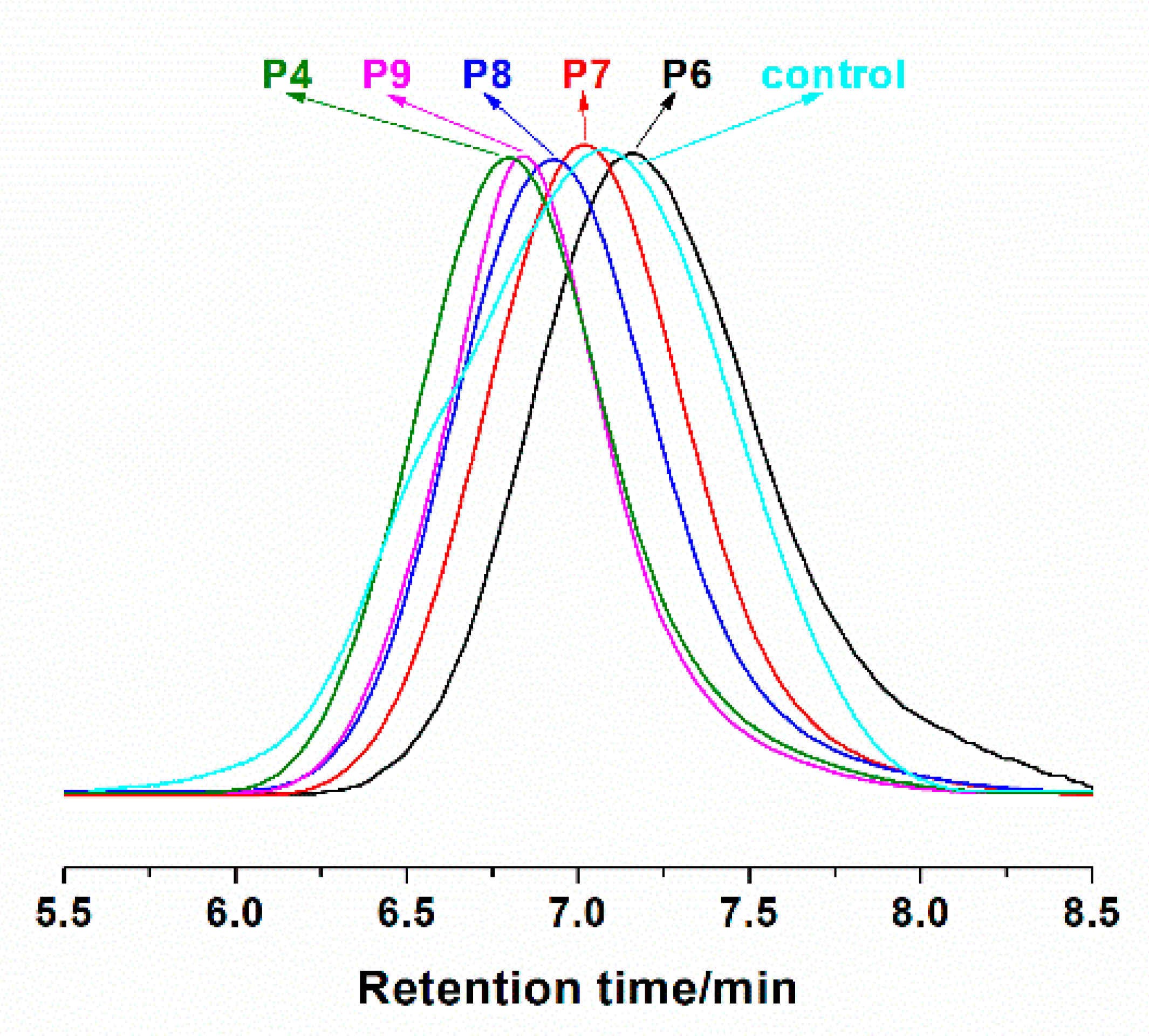



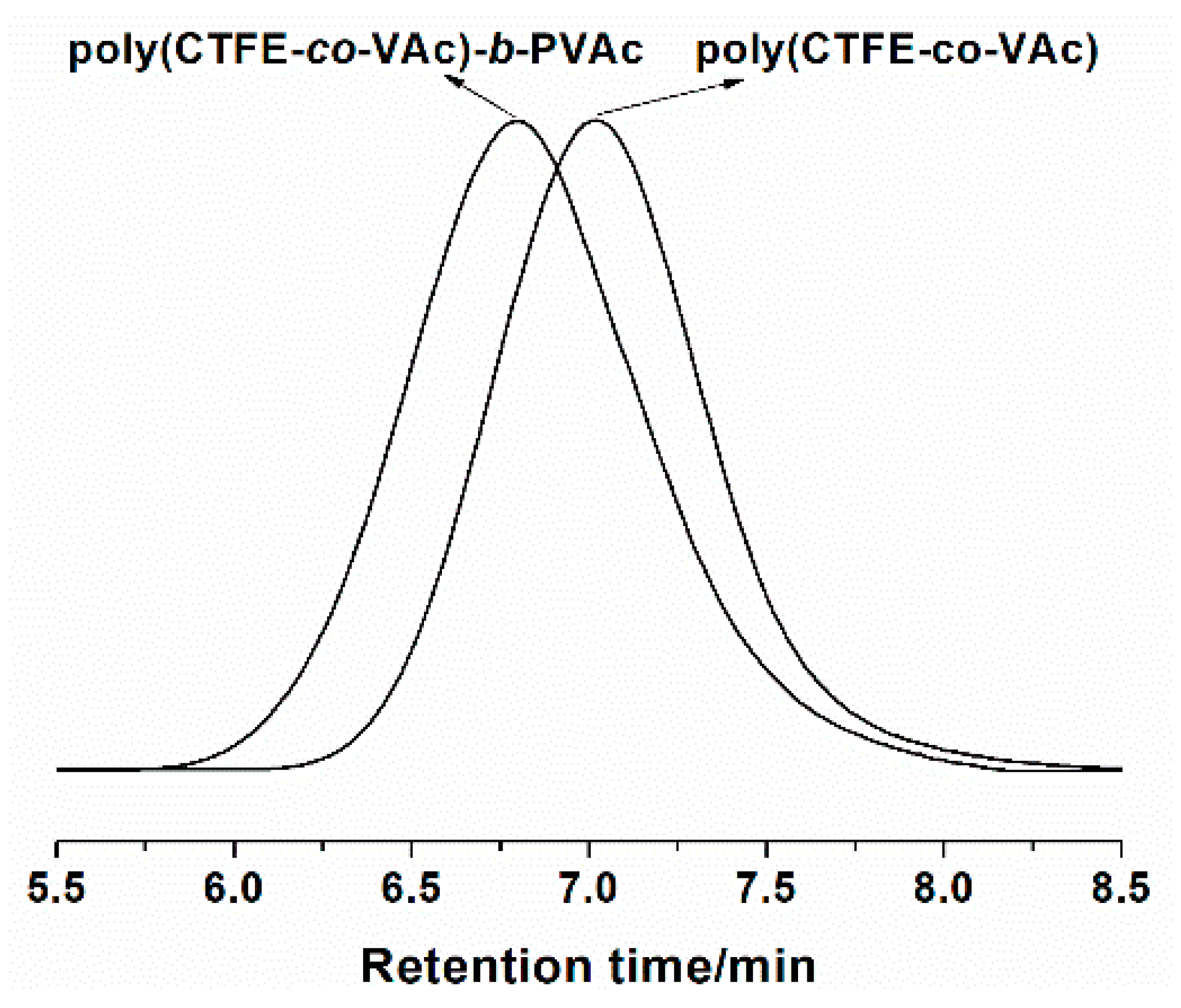

| Time (h) | [CTFE]0/[VAc]0 a | Elemental Analysis (wt%) | Copolymer Composition (mol%) | Conv. b | Mn,th | Mn,GPC | Ð d | |||
|---|---|---|---|---|---|---|---|---|---|---|
| C | H | CTFE | VAc | |||||||
| P1 | 6 | 1 | 39.66 | 3.57 | 38.4 | 61.6 | 0.586 | 18,600 | 36,300 | 1.53 |
| P2 | 6 | 2 | 38.02 | 3.82 | 42.9 | 57.1 | 0.582 | 20,200 | 39,700 | 1.52 |
| P3 | 6 | 3 | 36.73 | 3.75 | 46.6 | 53.4 | 0.587 | 22,000 | 40,400 | 1.52 |
| P4 | 6 | 4 | 36.33 | 3.20 | 47.7 | 52.3 | 0.591 | 22,700 | 40,100 | 1.57 |
| P5 | 1 | 4 | - | - | - | - | N c | - | - | - |
| P6 | 2 | 4 | 38.68 | 3.84 | 41.1 | 58.9 | 0.128 | 4300 | 7900 | 1.47 |
| P7 | 3 | 4 | 37.73 | 3.40 | 43.8 | 56.2 | 0.309 | 10,900 | 19,600 | 1.51 |
| P8 | 4 | 4 | 37.55 | 3.08 | 44.3 | 55.7 | 0.437 | 15,600 | 28,400 | 1.53 |
| P9 | 5 | 4 | 36.98 | 3.26 | 45.9 | 54.1 | 0.530 | 19,600 | 37,500 | 1.53 |
© 2019 by the authors. Licensee MDPI, Basel, Switzerland. This article is an open access article distributed under the terms and conditions of the Creative Commons Attribution (CC BY) license (http://creativecommons.org/licenses/by/4.0/).
Share and Cite
Wang, P.; Wang, H.; Dong, Q.; Bai, R. Cobalt-Mediated Radical Copolymerization of Chlorotrifluoroethylene and Vinyl Acetate. Polymers 2019, 11, 101. https://doi.org/10.3390/polym11010101
Wang P, Wang H, Dong Q, Bai R. Cobalt-Mediated Radical Copolymerization of Chlorotrifluoroethylene and Vinyl Acetate. Polymers. 2019; 11(1):101. https://doi.org/10.3390/polym11010101
Chicago/Turabian StyleWang, Pucheng, Hu Wang, Qibao Dong, and Ruke Bai. 2019. "Cobalt-Mediated Radical Copolymerization of Chlorotrifluoroethylene and Vinyl Acetate" Polymers 11, no. 1: 101. https://doi.org/10.3390/polym11010101
APA StyleWang, P., Wang, H., Dong, Q., & Bai, R. (2019). Cobalt-Mediated Radical Copolymerization of Chlorotrifluoroethylene and Vinyl Acetate. Polymers, 11(1), 101. https://doi.org/10.3390/polym11010101



